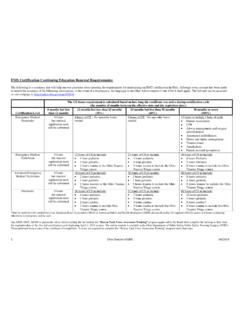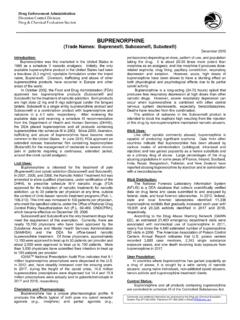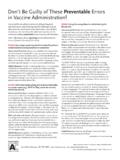Transcription of Scope of Practice - Ohio
1 1 Scope of Practice Approved by State Board of Emergency Medical, Fire and Transportation Services and the Ohio Department of Public Safety, Division of EMS This document offers an at-a-glance view of the Scope of Practice for Emergency Medical Responders (EMR), Emergency Medical Technicians (EMT), Advanced Emergency Medical Technicians (AEMT), and Paramedics as approved by the State Board of Emergency Medical, Fire, and Transportation Services (EMFTS Board). The authorized services can be found in sections (FR/EMR), (EMT-B/EMT), (EMT- I/AEMT), and (EMT-P/Paramedic) of the Revised Code. The scopes of Practice can be found in rules 4765-12-04 (EMR), 4765-15-04 (EMT), 4765-16-04 (AEMT), and 4765-17-03 (Paramedic) of the Administrative Code.
2 The Ohio EMS Scope of Practice authorized by the EMFTS Board applies to emergency and non-emergency settings. Performance of services outlined in this document and in the aforementioned code sections, shall only be performed if the EMR, EMT, AEMT, and Paramedic have received training as part of an initial certification course or through subsequent training approved by the EMFTS Board. If specific training has not been specified by the EMFTS Board, the EMR, EMT, AEMT, and Paramedic must have received training regarding such services approved by the local medical director before performing those services. The individual medical director of each EMS agency may limit or ask that providers obtain approval from medical direction for certain treatments.
3 Each medical director may need to tailor and revise their protocol to meet their community s needs and to fit their region and individual Practice , but they must ensure that all protocols remain within the approved Scope of Practice . EMS medical directors are reminded that they are not permitted to expand or exceed the Scope of Practice for EMS providers which has been authorized by the EMFTS Board; however, they may provide clarifications or limitations on services that are permitted. EMS medical directors and EMS providers are strongly encouraged to review the EMFTS Board s policy statement Regarding EMS Provider Prehospital Transport of Patients with Pre-Existing Medical Devices or Drug Administrations dated February 2018 (attached at the end of this document).
4 This statement clarifies how EMS providers, in the prehospital setting, should deal with medical devices and medicine administrations that are outside their Scope of Practice . Pursuant to rule 4765-6-04 of the Administrative Code, the EMFTS Board may allow EMRs, EMTs, AEMTs, and Paramedics to perform services beyond their respective scopes of practices as part of a board-approved research study. An entity must submit a research proposal to the EMFTS Board in accordance with the requirements of rule 4765-6-04 of the Administrative Code. The EMFTS Board is not obligated to approve the proposed research study nor accept any recommendation to permanently amend the Scope of Practice .
5 Updated 11/19/03; 5/17/05; 10/26/05; 10/17/07; 3/8/12; 8/22/13, 10/16/13, 12/18/13, 4/16/2014, 10/19/16, 2/15/17, 10/18/17, 6/20/18, 4/1/20, 1/1/21 2 State Board Emergency Medical, Fire and Transportation Services Ohio Department of Public Safety, Division of EMS Updated January 1, 2021 Airway Management EMR EMT AEMT PARAMEDIC 1 Open and maintain the airway x x x x 2 Oropharyngeal airway adjunct x x x x 3 Nasopharyngeal airway adjunct x x x x 4 Manual removal of obstructed airway x x x x 5 Laryngoscopy for removal of airway obstruction x x 6 Oral suctioning x x x x 7 Endotracheal (ET) tube suctioning through a previously established airway or a stoma x x x 8 Tracheostomy tube replacementA x x 9 Cricothyrotomy, surgicalA x 10 Cricothyrotomy, needleA x 11 Apply and obtain readings of pulse oximeter, CO-oximeter, and capnography or capnometry equipment x x x x 12 Oxygen administration a.
6 Nasal cannula x x x x b. Non-rebreather mask x x x x c. Mouth-to-barrier devices x x x x d. Partial rebreather mask x x x e. Venturi mask x x x 13 Ventilation management a. Bag valve mask x x x x b. Ventilation with a flow-restricted oxygen-powered device x x x x c. Positive pressure ventilation devices (manually triggered or automatic ventilators) x x x 14 Ventilator management - 16 years of age or olderA x 3 15 Non-emergent ambulance transport of a stable patient less than 16 years of age who has a chronic condition requiring a tracheostomy tube and a ventilator provided the patient s caregiver accompanies the patient during transport. The caregiver must have received appropriate training in use of the patient s ventilator.
7 A caregiver is not required to accompany the patient if the patient is accompanied by an Ohio licensed registered nurse or respiratory therapist, or other appropriately trained and licensed Ohio healthcare x 16 Orotracheal intubationA x a. Apneic patients x x b. Pulseless and apneic patients x x 17 Nasotracheal intubationA x 18 Dual lumen airwayA x a. Apneic patients x x b. Pulseless and apneic patients x x x 19 Extraglottic airwaysA x a. Apneic patients x x b. Pulseless and apneic patients x x x 20 CPAP administration and management x x x 21 BiPAP administration and management x 22 Positive end-expiratory pressure (PEEP) x 23 End tidal CO2 monitoring and detecting x x x 24 Oxygen humidifier equipment application and monitoring x x x 25 Chest tube monitoring and management x 26 Nasogastric (NG) tube placement x 27 Orogastric (OG) tube placement x Cardiac Management EMR EMT AEMT PARAMEDIC 1 Cardiopulmonary resuscitation (CPR) x x x x 2 Chest compression assist devices X x x x 3 Automated external defibrillator (use of an AED)
8 X x x x 4 Manual defibrillation x x 5 Negative impedance threshold devices x x x 4 6 administration of cardiac medication x 7 Set up cardiac monitor in the presence of an AEMT or Paramedic x 8 Cardiac monitor strip interpretation x x 9 Cardioversion x 10 Carotid massage x 11 Transcutaneous cardiac pacing x 12 12-lead EKG performance and interpretation x 13 12-lead EKG application assisting a Paramedic who is present x x 14 12-lead EKG set up and application for electronic transmission B x x x A The utilization of waveform capnography is mandatory for all patients requiring invasive airway devices with the exception of stable patients with no cardiac or pulmonary complaints or symptoms unless ordered by the transferring physician.
9 An invasive airway device is any airway device inserted or pre-positioned into a patient's airway by means of the mouth, directly into the trachea, or into the trachea by means of a tracheostomy tube, cricothyrotomy or nasotracheal intubation. Dual lumen and extraglottic airways, even though they are blindly inserted into the hypopharynx or the esophagus, are considered invasive airway devices. BAn EMT or AEMT may set up and apply a 12-lead electrocardiogram when assisting a Paramedic or for the purposes of electronic transmission if all of the following conditions are met: 1) performed in accordance with written protocol; 2) EMT or AEMT shall not interpret the electrocardiogram; 3) delay in patient transport is minimized; and 4) EKG is used in conjunction with destination protocols approved by the local medical director.
10 Medical Management EMR EMT AEMT PARAMEDIC 1 Epinephrine administration via auto-injector x x x x 2 Epinephrine administration via SQ or IM routes x x 3 Epinephrine administration via IV or IO route x 4 Aspirin administration x x x 5 Oral glucose administration x x x 6 Activated charcoal administration x x x 7 Nitroglycerin administration (patient assisted) C x x x 8 Nitroglycerin administration (non-patient assisted) x x 9 Aerosolized or nebulized medications administration (patient assisted) C x x x 10 administration of aerosolized or nebulized medications (non-patient assisted) x x 11 Naloxone administration via auto-injector x x x x 12 Naloxone administration via intranasal route x x x x 5 13 Naloxone administration via ETT, IM, IV, IO, or SQ routes x x 14 medication administration (protocol-approved)D x x 15 administration of intranasal medications (in addition to naloxone) D x x 16 Immunizations for influenza to firefighters, EMTs, AEMTs, or Paramedics (ORC )





